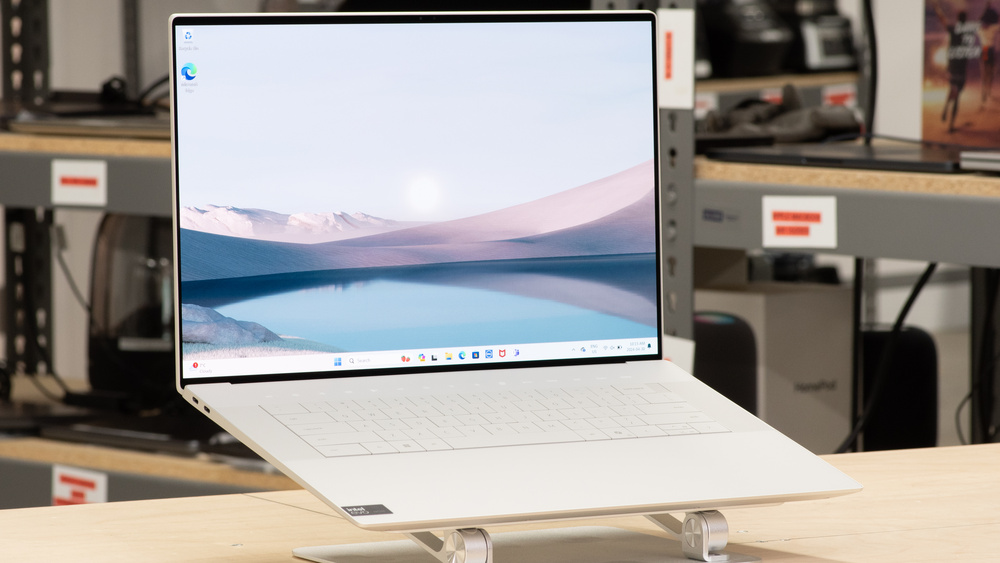Dell XPS 16 (2024) Review: A Creative Powerhouse?
Dell’s XPS line has long been synonymous with premium design and capable performance. The 2024 XPS 16 model aims ambitiously at creators—video editors, designers, developers—with robust hardware, stunning visuals, and cutting-edge features. But does it truly deserve the “powerhouse” label? Or does its sleek exterior mask compromises better suited to flash than substance? Let’s unpack its strengths and trade‑offs across key creative benchmarks.
🎨 Design & Build Quality
Unmistakably XPS: minimalist aesthetics, sturdy aluminum-and-carbon‑fiber chassis, and a massive 16.3″ display with razor-thin bezels. Dell’s new invisible haptic touchpad creates a seamless palm‑rest experience—cool and refined, though it may take time to find your typing equilibrium .
Keyboard update? Physical function keys are gone, replaced by a capacitive, touch-sensitive row. It’s sleek—but for power users who depend on function-key input, the trade‑off could hinder productivity wired.com. The keyboard is visually striking yet polarising in practice.
Ports are limited. Three USB‑C/Thunderbolt 4 ports and a headphone jack—with only a MicroSD slot for expansion—are underwhelming at this size, especially for creators who juggle peripherals, external drives, and displays . Dell’s included dongle softens the blow, but it’s still an extra piece to keep track of.
Verdict: Gorgeous and premium, but demanding of adaptation—especially for those expecting familiar tactile experiences and richer connectivity.
🌟 Display & Audio Performance
OLED glory. The optional 3.5K (3840×2400) OLED panel is a visual treat: vibrant 100% DCI‑P3 color, deep blacks, and Dolby Vision support. Editors and designers will appreciate the high-contrast image quality and accurate color reproduction .
Variable refresh rates (up to 90Hz) help reduce flicker and make UI interaction smoother , though for dedicated gaming a higher Hz might have pushed it closer to enthusiasts’ tastes.
Speakers & mic: A quad-speaker array tuned by Waves MaxxAudio Pro delivers surprisingly full sound—clear vocals and decent bass, great for editing or streaming .
Webcam: A solid 1080p camera with integrated Windows Hello support, offering improved clarity in video calls compared to most ultrabooks .
💻 Performance & Thermal Management
Under the hood, the XPS 16 is built as a creative workhorse:
-
CPU: Intel Core Ultra 7/9 (Meteor Lake) – 16 cores, up to 5 GHz clock speed wired.com+15pcworld.com+15dutchiee.tv+15howtogeek.com+9tweaktown.com+9pcmena.com+9.
-
GPU: Intel Arc integrated or optional NVIDIA RTX 4050/4060/4070 Laptop GPUs with up to 60 W TGP howtogeek.com+2tweaktown.com+2pcworld.com+2.
-
Memory: Up to 64 GB LPDDR5X (6400–7467 MT/s) tweaktown.com+1reddit.com+1.
-
Storage: 512 GB to 4 TB PCIe Gen 4 NVMe SSD .
Benchmark performance: Expert Reviews reported strong multimedia results—91 fps in SPECviewperf at Full HD and 59 fps at 4K for 3D modeling. On 1080p, Cyberpunk 2077 hit ~60 fps at max with DLSS and frame-gen enabled; Metro Exodus managed ~55 fps .
However, GPU limited compared to thicker, more expansive gaming-focused laptops: Notebookcheck noted that while CPU power is robust, GPU performance lags vs competitors offering more flexible TGP profiles .
Thermals: The chassis remains surprisingly cool; however, fans can get loud under load . Sustained performance is there, but noise is the cost.
Real-world usage: PCWorld praised snappy CPU responsiveness and well-managed thermals, though suggested it falls short in sustained heavy-graphics workflows reddit.com. Dell’s balanced approach favors efficiency over raw thermal output—perfect for travel, less so for long render jobs.
🔋 Battery Life & Portability
Packed with a nearly max-size 99 Wh battery, the XPS 16 offers competitive stamina for a high-end OLED laptop:
-
PCWorld loop test: ~975 minutes video playback (~16 h), but reduced to ~10 h with adaptive brightness reddit.com+9pcworld.com+9blogs.windows.com+9.
-
Tom’s Guide web test: ~11 h browsing on low brightness tomsguide.com+1tomsguide.com+1.
-
NotebookCheck & Expert Reviews: More typical multitasking yields ~8 h of heavy use .
How should creators interpret this? Around a full workday with light editing and design, especially if you use the integrated GPU. Expect less runtime during intensive GPU work, but still respectable for this visual-rich chassis .
Portability is about 4 lb—manageable for travel, though the full metal build and thermal assembly give it a substantial feel compared to featherweight ultrabooks.
🔌 Connectivity & Expandability
Ports:
-
3× USB-C (Thunderbolt 4/USB-C 3.2 Gen2 depending on GPU version)
-
1× 3.5 mm audio jack
-
1× micro-SD reader
-
No USB-A, HDMI, or Ethernet built-in; requires adapter for legacy devices tomsguide.com.
Dell includes a combo dongle—thankfully—but creators often rely on multiple external drives, displays, and memory cards, making diverse ports a tactical requirement.
Upgradability:
-
RAM is soldered (max 64 GB).
-
Single SSD slot—some users express frustration at lack of expansion .
🤝 User Experience & Edge Cases
White-glove aesthetic: “Appled in some ways”—clean trackpad, minimalist visuals, premium premium feel .
Typing & touchpad: Haptic pad is responsive and accurate, but touch function row and invisible keys require acclimation—and some users find them sloppy for precise typing .
Battery vs. screen trade-off: Opt for FHD panel for maximum runtime (lighter/dimmer), or OLED for visual fidelity with reduced hours .
Performance bumps & falls: RTX 4070 option ups GPU might but add $800; 4050/4060 still deliver 60fs 4K media editing .
Real-user anecdotes:
Some report sluggish UI and even basic use lag after heavy patching or bloat—but others praise its endurance, sometimes matching MacBook Pro under similar brightness wired.com+6reddit.com+6reddit.com+6.
✅ Summary: Creative Suitability
Strengths
-
Brilliant OLED touch display with vivid colors and high contrast—ideal for creative workflows.
-
Powerful CPU + adequate GPU, supportive of video editing, 3D modeling, code compiling.
-
Premium build: precise haptics, minimalist design, solid audio and webcam.
-
Solid battery for its class—up to 16 h in light use.
Weaknesses
-
Limited ports and no USB-A/HDMI/Ethernet without dongles.
-
Soldered RAM and single storage slot hamper future upgrades.
-
GPU thermal constraints limit heavier CAD/rendering or gaming.
-
Touch function row and flat keyboard divide opinions.
-
High price: Premium for a creative laptop, but not quite workstation-tier power/capacity pcmena.comblogs.windows.com+5techcodex.com+5en.wikipedia.org+5.
🔍 Final Verdict
The 2024 Dell XPS 16 is not a raw-power beast like hulking gaming laptops or workstation-grade machines. Instead, it presents a balanced creative package—blending crisp display, strong CPU, and portable design in a sleek all-metal frame.
-
Creative professionals who prize display fidelity, build quality, and battery life will find much to love.
-
Video editors and 3D artists needing extended GPU performance may wish for thicker chassis or bigger cooling systems.
-
Power users relying on extensive port connectivity or upgradeability may find it frustrating without adapters or future memory expansion.
At its starting price (~$1,699), it’s a luxury for creatives who prefer refined style and reliable daily performance. Configure it with the RTX 4070 and OLED and the cost climbs rapidly—placing it against more powerful but bulkier alternatives.
Is it a creative powerhouse? For many creative workflows—graphic design, software development, photo editing—the answer is yes. But if your day-to-day includes heavy CGI renders, multiple external displays, or future-proof expansion, consider alternatives like a mobile workstation or full-fledged creative desktop. The XPS 16 shines brightest when artistry meets portability.

